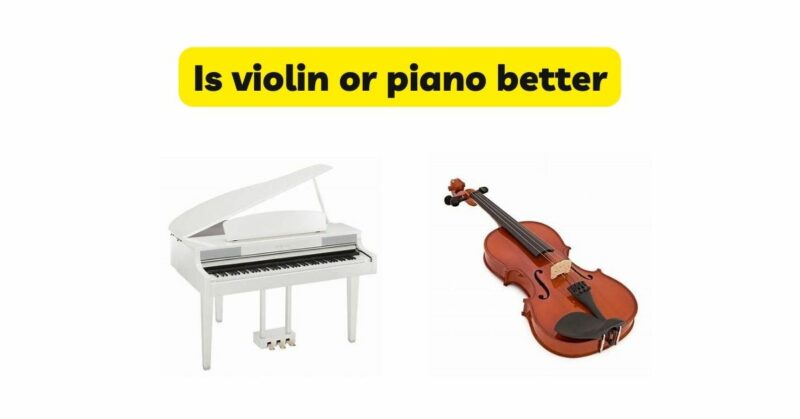The violin and the piano are two distinguished musical instruments that have captivated audiences for centuries. While it may be tempting to compare the two and label one as “better,” such a judgment oversimplifies the nuanced qualities and artistic possibilities each instrument offers. In this article, we will delve into the distinct characteristics of the violin and the piano, highlighting their strengths and the unique musical experiences they provide. By understanding the individual merits of each instrument, you can appreciate their inherent beauty and recognize that their value lies in their differences rather than in a singular notion of superiority.
- Expressiveness and Emotional Range: The violin is renowned for its expressive capabilities, often described as the instrument closest to the human voice. With its rich and warm tones, the violin excels in conveying emotions and capturing the nuances of musical phrasing. Its ability to sustain long, singing notes and produce delicate and expressive vibrato adds depth and emotion to performances. Conversely, the piano boasts a wide dynamic range, from whispering pianissimo to thunderous fortissimo. It offers the pianist the ability to create a vast array of tonal colors and textures, enabling intricate expressiveness and dramatic interpretations.
- Versatility and Repertoire: Both the violin and the piano boast extensive repertoires spanning various genres, yet their versatility lies in different musical contexts. The violin shines in the realm of classical music, with a vast collection of solo, chamber, and orchestral repertoire. It is deeply ingrained in the tradition of virtuosic performances and showcases the instrument’s technical brilliance and emotional depth. On the other hand, the piano’s versatility allows it to adapt to a wide range of musical genres, including classical, jazz, pop, and contemporary music. Its ability to play harmonies, melodies, and bass lines simultaneously makes it suitable for solo performances, accompaniment, and ensemble playing.
- Technical Demands and Challenges: Both instruments present unique technical challenges that require dedication and practice. The violin demands precise finger placement, bow control, and a keen sense of intonation. Its physicality and the need for coordinated bowing techniques and left-hand agility contribute to a steep learning curve. Conversely, the piano requires independent coordination of both hands, with each hand executing different melodies, harmonies, and rhythms simultaneously. The pianist must develop finger dexterity, hand independence, and a strong sense of touch and control to navigate the keyboard effectively.
- Instrumental Roles and Collaborative Opportunities: The roles and collaborative opportunities offered by the violin and the piano differ significantly. The violin is often associated with solo performances, chamber music, and orchestral playing. Its lyrical melodies and expressive capabilities make it well-suited for taking the spotlight in solo repertoire and concertos. Alternatively, the piano lends itself to a wide range of collaborative opportunities, from accompanying singers and instrumentalists to performing as part of a larger ensemble. Its ability to provide harmonic support and play complex arrangements allows for versatile musical collaborations.
- Personal Preference and Musical Affinity: Personal preference plays a significant role in determining which instrument may be better suited to an individual. Some individuals may be naturally drawn to the expressive qualities of the violin, while others may feel a deeper connection to the vast harmonic possibilities of the piano. The choice between the two often comes down to personal affinity, the type of musical expression one wishes to pursue, and the emotional connection one feels with each instrument.
- Learning Experience and Enjoyment: The learning experience and enjoyment factor are essential considerations when determining which instrument is better for an individual. Learning the violin requires patience, dedication, and a willingness to embrace the physical challenges that come with mastering the instrument. On the other hand, the piano offers a more visual and tactile learning experience, where one can quickly grasp music theory concepts and experience the joy of playing harmonies and melodies simultaneously. The enjoyment derived from learning an instrument depends on personal preferences and the fulfillment one derives from the unique learning process and the eventual mastery of the chosen instrument.
Conclusion: In conclusion, labeling the violin or the piano as “better” undermines the inherent beauty and artistic possibilities that each instrument offers. The violin’s expressive qualities and emotional depth provide a captivating musical experience, particularly in the realm of classical music. Meanwhile, the piano’s versatility, tonal range, and harmonic capabilities offer a wide array of musical genres and collaborative opportunities. The choice between the two ultimately comes down to personal preference, affinity, and the desire to explore different musical expressions. Whether you find solace in the ethereal tones of the violin or the harmonious complexity of the piano, both instruments possess unique charms and endless possibilities for musical expression and enjoyment. Embrace the instrument that resonates with your soul and embark on a musical journey that speaks to your heart.


